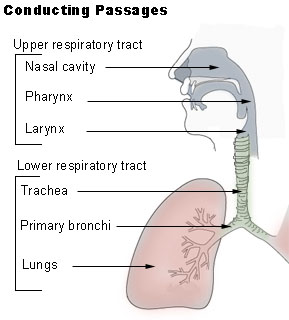- Upper respiratory tract infection

Caption = Conducting passages.Upper respiratory tract infections, (URTI or URI), are the illnesses caused by an acute
infection which involves the upperrespiratory tract :nose , sinuses,pharynx orlarynx .igns and symptoms
Acute upper respiratory tract infections include rhinosinusitis (common cold),
sinusitis ,pharyngitis /tonsillitis ,laryngitis and sometimesbronchitis . Symptoms of URTI's commonly includenasal congestion ,cough , running nose,sore throat ,fever , facial pressure andsneezing . Onset of the symptoms usually begins after 1-3 days after exposure to a microbial pathogen, most commonly a virus. The duration of the symptoms is typically 7 to 10 days but may persist longer.Up to 15% of acute pharyngitis cases may be caused by bacteria, commonly
Group A streptococcus inStreptococcal pharyngitis ("Strep Throat"). Generally, patients with strep throat start with a sore throat as their first symptom and usually do not have runny nose or cough or sneezing.Pain and pressure of the ear caused by a middle ear infection (
Otitis media ) and the reddening of the eye caused by ViralConjunctivitis are often associated with upper respiratory infections.Influenza (the flu) is a more systemic illness which can also involve the upper respiratory tract.Treatment
Judicious use of antibiotics can decrease unnecessary adverse effects of antibiotics as well as out-of-pocket costs to the patient. But more importantly, decreased antibiotic usage will prevent development of drug resistant bacteria, which is now a growing problem in the world. International, as well as local US health agencies, have been strongly encouraging physicians to decrease the prescribing of antibiotics to treat common upper respiratory tract infections because antibiotic usage does not significantly reduce recovery time for these viral illnesses.cite journal | author = Reveiz L, Cardona AF, Ospina EG | title = Antibiotics for acute laryngitis in adults | journal = Cochrane Database Syst Rev | volume = | issue = 2 | pages = CD004783 | year = 2007 | pmid = 17443555 | doi = 10.1002/14651858.CD004783.pub3] . Some have advocated a delayed antibiotic approach to treating URIs which seeks to reduce the consumption of antibiotics while attempting to maintain patient satisfaction. Most studies show no difference in improvement of symptoms between those treated with antibiotics right away and those with delayed prescriptions.cite journal | author = Spurling GK, Del Mar CB, Dooley L, Foxlee R | title = Delayed antibiotics for respiratory infections | journal = Cochrane Database Syst Rev | volume = | issue = 3 | pages = CD004417 | year = 2007 | pmid = 17636757 | doi = 10.1002/14651858.CD004417.pub3] Most studies also show no difference in patient satisfaction, patient complications, symptoms between delayed and no antibiotics. It should be noted that a strategy of "no antibiotics" results in even less antibiotic use than a strategy of "delayed antibiotics". Until more effective treatments are available to treat the common respiratory viruses responsible for the majority of cases, "treatment of URIs with rest, increased fluids, and symptomatic care with over-the-counter medications will remain the treatment of choice". However, in certain higher risk patients with underlying lung disease, such as
chronic obstructive pulmonary disease (COPD), evidence does exist to support the treatment of URIs with antibiotics to shorten the course of illness and decrease treatment failure.cite journal | author = Ram FS, Rodriguez-Roisin R, Granados-Navarrete A, Garcia-Aymerich J, Barnes NC | title = Antibiotics for exacerbations of chronic obstructive pulmonary disease | journal = Cochrane Database Syst Rev | volume = | issue = 2 | pages = CD004403 | year = 2006 | pmid = 16625602 | doi = 10.1002/14651858.CD004403.pub2]The use of
Vitamin C in the prevention and treatment of upper respiratory infections has been suggested since the initial isolation of vitamin C in the 1930s. Several studies have failed to demonstrate that vitamin C supplementation reduces the incidence of colds in the normal healthy population, indicating that routine large dose prophylaxis with Vitamin C is not beneficial in widespread community usage. Some evidence exists to indicate that it could be justified in persons exposed to brief periods of severe physical exercise and/or cold environments. The evidence does not support the use of Vitamin C at the onset of colds as effective therapy.cite journal | author = Douglas RM, Hemilä H, Chalker E, Treacy B | title = Vitamin C for preventing and treating the common cold | journal = Cochrane Database Syst Rev | volume = | issue = 3 | pages = CD000980 | year = 2007 | pmid = 17636648 | doi = 10.1002/14651858.CD000980.pub3]ee also
*
Lower respiratory tract infection
*Common Cold References
* Park, David J. "Evidence Based Approach to Upper Respiratory Infections." December 10, 2006. Touro University Nevada College of Osteopathic Medicine
External links
* [http://familydoctor.org/x4957.xml The Flu and Cold: Tips on Prevention and Feeling Better]
* [http://www.clevelandclinicmeded.com/diseasemanagement/infectiousdisease/urti/urti.htm Medicine Index - Upper Respiratory Tract Infection]
Wikimedia Foundation. 2010.
